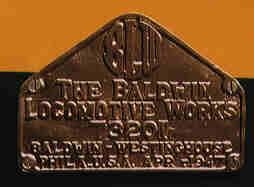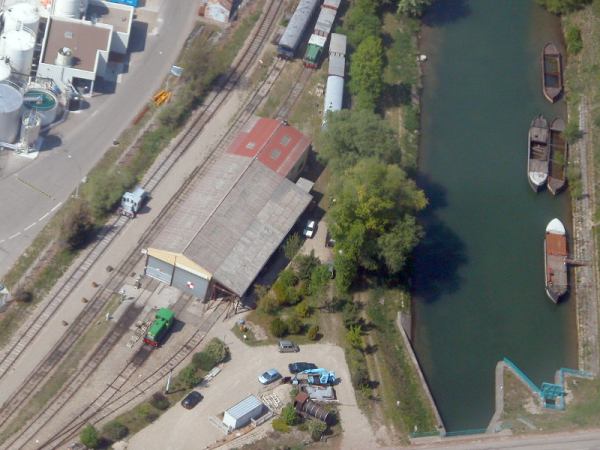General technical data of the
locomotive:
| Builder: |
Baldwin
Locomotive Works, Philadelphia, Pennsylvania |
| Model/Type: |
DRS 6-4-660,
N° 72926 |
| Date of delivery: |
28th of dec.1946 |
| Road numbers: |
040DA29 then
A1A-A1A 62029 |
| Diesel power [kW/HP]: |
560/750 |
| Locomotive power
[kW]: |
398 |
| Maximum starting tractive
effort [kN]: |
208 |
| Maximum safe speed
[km/h]: |
96 then 80 |
| Weight in working
order [t]: |
109,5 |
| Total length [m]: |
17,72 |
| On-board voltage
[V]: |
130 |
General
characteristics
of the prime mover:
| Builder: |
Baldwin
Locomotive Works, Philadelphia, Pennsylvania |
| Model/Type: |
DeLaVergne type
606 NA |
| Cycle: |
4 stroke |
| Air supply: |
Naturally
Aspirated |
| Max.Power [kW] @
engine speed [rev/min]: |
560 @ 625 |
| Specific fuel
consumption
[g/kWh]: |
233 |
| Fuel consommation
@ Pmax [l/h] |
174 |
| Max.Torque [Nm]: |
8550 |
| Break Mean Eff.
Pressure [bar]: |
5,5 |
| Piston speed [m/s]: |
8,21 |
| Number of
cylinders [-]: |
in Line 6 |
| Bore
* Stroke [mm * mm]: |
324*394 |
| Displacement
(cylinder
/ total) [l]: |
32,48 / 194,9 |
| Total mass of
engine [kg]: |
12644 |
| Cooling method: |
water |
| Starting method: |
electric using
the main generator |
| Injection system: |
1 Bosch injector et
1 high pressure Bosch
pump for each cylinder |
Diesel prime mover builder plate:

General view:

Builder plate:

Short presentation:
This
locomotive is certainly the most impressive of our collection. Its
prime mover and its fantastic sound is the reason for the high interest
for it among the
railfans in France.
The
100 A1A-A1A 62000 (former 040DA) were built between april 1946 and
august 1947 from the Baldwin Locomotive Works in Eddystone, in the suburb of
Philadelphia in Pennsylvania and delivered to the french state railways
SNCF, in the
framework of the Lend/lease programm which goal was to rebuild Western
Europe
after WW2. The well known Mikado 141R were also part of this plan.
For
the Baldwin Builder, which was specialized since decades in the
construction of steam locomotives in the USA (like ALCO and LIMA), this
series is paradoxically its first large production experience for
diesel locomotives. The precedent series for the domestic market
were by far smaller.
First
registered under the number 040DA (figure "4" for 4 drive axles, "D"
for Diesel and "A" because these locomotives were the first diesel
series in France) they were
renamed "62000" in 1962 after the renumbering of the entire SNCF
locomotives fleet.
These
diesel-electric locomotives are equipped
with a slow-running (max 625rpm), in-line 6 cylinder, 4-stroke,
water cooled naturally aspirated Diesel engine from
the 600-series. For each cylinder there is one cylinderhead equipped
with 2 intake and 2 exhaust valves. These are controlled through a
unique camshaft using two push rods and two levers. In the original
engine called "VO", the combustion chamber was integrally built in the
cylinderhead, a design which caused a lot of
troubles that could not be corrected very soon because of the
restrictions of the War Production Board (who prohibited design changes
during WW2). The 600-series engine is a enhancement from the VO engine.
One of the major change involves the combustion process. Therefore the
cylinderhead has been completely redesigned and the VO flat top
piston replaced by a Hesselmann-type piston with open combustion
chamber principle. Fuel is now direct-injected in the combustion
chamber using a Bosch high-pressure pump and one injector for each
cylinder.
It
is started by the prime generator which is shortly fed with
current from the batteries. These were first lead batteries, then
cadmium-nickel (for more than 40 years!) and now again lead-acid
batteries (9 of 180Ah capacity).
The
engine drives directly the prime generator, a
double stage
air-compressor from type "CD" (Westinghouse) and the propeller of the
fan
which cools down the water and oil radiators and the two blowers of the
traction
motors. The exciter and auxiliary generators are driven by
V-belts, like the ventilators for the traction motors are. All these
equipments are delivered by Westinghouse.
Note
that despite its (even for the US of the 40's) impressive
dimensions, (displacement of 194L that's to say nearly 33L per
cylinder), its engine is only rated at 750HP/492kW which is what the
workshops of the SNCF have adjusted the injection pumps to. After all
said
auxiliaries, only 497kW are available for the prime generator.
The
engine belongs to the 600 series and is called 606NA because of its 6
cylinders and the Naturally Aspiration. The NA versions were rated from
660HP/492kW to 750HP/560kW. These engines were later turbocharged and
called 606SC. They were rated between 1000HP/746kW and
1325HP/988kW. The biggest versions of the 600 series were (and still
are) the in-line 8 cylinders versions. Generally speaking, the number
of 8 cylinders, naturally aspirated version is limited. These NA
engines were rated at
1000HP/746kW but soon replaced by the 606SC with the same power
output with 2 cylinders less. The 608 engine were later also
supercharged and called 608SC. They could deliver between 1500HP/1119kW
and
1750HP/1305kW power output.
The
prime generator has a separate excitation. This excitation winding
is fed by an exciter from which the excitation is composed of shunt
(positive), a serial (negative) and a separate winding fed by the
auxiliary generator. The current through this separated winding is
limited by a system called "Carbonstat" (TS31) which purpose is to
avoid
the diesel engine to stall if the torque demand of the generator is too
high. A modification done by the SNCF was to allow the locomotive
engineer to vary directly this current by adding or subtracting
resistors
in this circuit. The driver can now choose the tractive effort at a
given diesel engine speed.
The
brake is an Westinghouse specialty: it is a kind of a triple
valve. The GE has a similar system. It
is a distributor 6 DKR which can be found as well on the 141R.
The
chassis and the trucks are in cast steel. These trucks were first used
on steamlocomotives or on their tenders and are equiped with 3 axles
and 2 nose-suspended electrical traction motors from type Westinghouse
362 with 4 poles. The 14/68 gearing
allows a maximum safe speed of 96km/h (60mph). Suspension
uses leaf and helix springs and is fully equalized. The connection
between chassis and trucks is also original.
These
locomotives were the first experience of dieselization on a large scale
for the french national railways, more through necessity then by
choice. The reconstruction of France was at that time an absolute
priority.
Very soon, the trucks revealed to be very agressive for the track and
the maximum safe speed has been limited to 80km/h (50mph). Also the
journal boxes need continuously lubrication made by hand (Symington).
This precluded early their use on long distance. So, they were
more and more used only for yard works for example at humps,
especially in the North (coal ore) and the Lorraine (iron ore). On both
sides of
the atlantic the Baldwin excelled on mining regions: Pennsylvania is
the equivalent of the french Lorraine or the german Ruhr regions. They
were very suited to the service on humps where the locomotive pushs
long trains at
a slow and regular speed with high tractive effort. The Westinghouse
electric equipment
was oversized (generator and traction motors were used on 1000HP
locomotives) so that they could withstand high overloads without majour
problems.
Life at CFTR:
| Last owner before salvage: |
SNCF |
| Retirement date: |
1982 |
| Acquisition date: |
1983 |
| Current owner: |
Private
(founding member) |
| Restauration: |
all the time! |
| Use at the CFTR: |
Run the train from depot to the
station and switching at Sans-Soucis |
| Retirement by the CFTR: |
- |
Our
62029 (Building number 72926 and not 73201 like above picture shows!
This number is that one of the 62086) has been bought in Lens
(North of France) in 1983 by a founding member. It was not too
difficult to repair it as it was just overhauled by the workshop there.
Now, our baldwin is operated regularly to pull
train to the station and switch at Sans-Soucis and every driver
enjoys it. First of all, the webmaster who drives it, secondly the
railfans
who take pictures of it and thirdly the oil industry because of its
higher turnover.
In
2014, some difficult work had to be done: a roller bearing of one of
the traction motors was defective and had to be replaced. But it is
like the cathedral of Strasbourg: you begin here, continue there
and you never stop repairing!
Pictures (CFTR):

Changing a
traction motor? No problem, we can do that! (Photo
Sébastien Kieffer)
Bibliography and links:
- Loco-revue documentary file;
- SNCF caracterstic file;
- trains miniatures
n°19, mai-juin 1988;
- Voies
Ferrées 78, juillet-août 1993;
- Diesel Locomotives:
the first 50 years, Louis A. Marre, Kalmbach Books, 1995.
- Train Shed Cyclopedia
n°60, Newton K.
Gregg, 1977.
- Diesels from Eddystone: the story of Baldwin diesel
Locomotives , Dolzall, Kalmbach Books, 1984
- The Diesel Builders, Volume three, Baldwin Locomotive
Works, John F. Kirkland, Interurban Press, 1994
- Diesel Locomotives,
Cyclopedia volume 2, compiled by Bob
Hyden, Kalmbach Books, 1980.
- La traction
électrique et diesel-électrique,
Pierre PATIN, collection des chemins de fer aux éditions
Léon Eyrolles, 1952.
More information?
A more comprehensive article is in process, juste wait a little!





